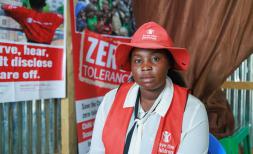The effects of climate change and the need to invest in nutrition to avert a disaster

Tasnim*, 63, feeds milk to her severely malnourished six month old grandson *Garad at a Save the Children supported stabilisation center in Garissa, Kenya.
Today, Kenya, along with the rest of the Horn of Africa, is experiencing one of the worst droughts in 40 years. Over 4.35 million Kenyans are going hungry while over 942,000 children require urgent treatment for acute malnutrition.
One of the main causes of this unprecedented two-year drought is climate change, which has generated a lot of debate at the ongoing COP 27 summit, with climate change adaptation being one of the key highlights of this year’s discussions. Climate change is a long-term threat to food security and nutrition; it reduces crop yields, impairs nutrient quality and dietary diversity, and disrupts water and sanitation.
Save the Children’s recent Generation Hope report shows that 774 million children in the world are exposed to high climate risks. It found that over 100 billion dollars could be saved every year responding to disasters if contingency planning, social protection and financial inclusion were improved.
However, without such contingency planning, the lives and livelihoods of millions are at risk. Tragically, in the Horn of Africa alone, one person dies from hunger every 48 seconds! Kenya’s Turkana, Mandera, Garissa and Wajir counties are experiencing worse malnutrition levels than in the 2011 Horn of Africa crisis and 2017 Drought Emergency.
What are the human stories behind these shocking figures?
In Turkana, 34.8%[1] of children are malnourished. To put this into perspective, the malnutrition prevalence threshold in emergencies is 15%. This is forcing families to go without meals for days, while others are making do with plain boiled maize (corn) as a meal.
Patrick Kalale, Nutrition Officer, Save the Children’s Turkana Field Office, reports that the situation is further deteriorating, with mothers having to share the food supplements meant to treat their malnourished children with their other ‘healthy’ children.
Furthermore, Akalale, a mother of a 16-month-old child, was so malnourished to a point you could not tell she was pregnant. As shocking as this is, Turkana county is not alone in this regard. In Kenya, over 115,700 pregnant and breastfeeding women are currently acutely malnourished and in need of urgent treatment.
While in Garissa, Katra Farah, Nutrition Officer at Save the Children’s Garissa Field Office, reveals that “thousands of children are struggling to get food with some school-going children dropping out of school because of the biting hunger.”
What are we doing?
Save the Children has supported 350 emergency integrated outreaches to provide health, nutrition, Water Sanitation and Hygiene (WASH) and protection services to children under 5 and their households who can’t access health facilities due to long distances. 124,970 children under 5 years and 57,256 pregnant and breastfeeding women have been screened and treated for malnutrition.
Farmers in Garissa and Wajir have benefitted from animal feeds and livestock vaccination to prevent infectious diseases. We have also scaled up cash transfer to families in Garissa, Wajir, Turkana and Mandera.
At the national level, as part of the Global Malnutrition Initiative, Save the Children in collaboration with other partners has been advocating for policy and protocols that will allow Community Health Workers to treat acute malnutrition alongside other related sicknesses such as pneumonia. And we continue to advocate for increased health and nutrition financing at the national and local levels.
The need for international political leadership
The situation has reached unprecedented levels of need, yet the funding gap is fast drying up. Only 60% of the population in need has been reached with lifesaving interventions.
We call upon governments, G7 and western leaders, international communities and partners to invest adequate resources, especially for the lower income countries towards climate adaptation, addressing losses and damages that threaten the full realization of the rights of children.
We further call upon them to increase financial assistance towards humanitarian emergency response in the Horn of Africa to avert loss of human life and loss of livelihoods. Lastly, a multi-sectoral approach in addressing malnutrition and food insecurity in the Horn of Africa is needed.
Interested in learning more about our response to the Hunger Crisis? Click here to find out.
[1] Turkana Smart Survey Report 2022







